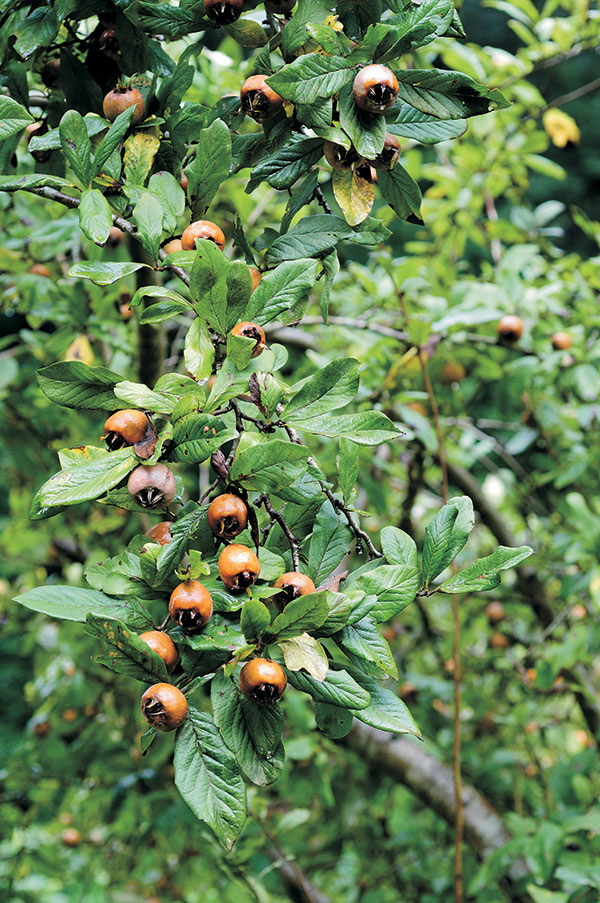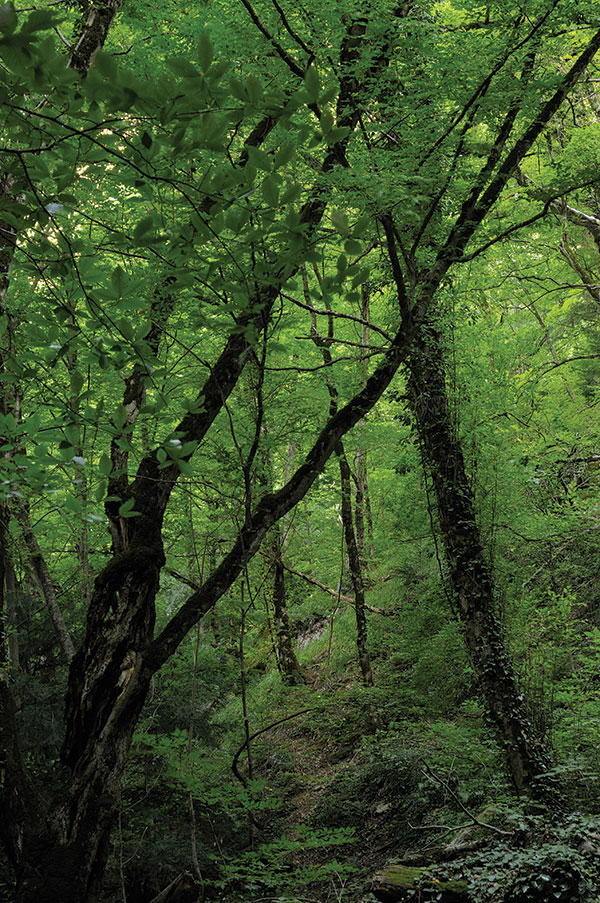In terms of the total number of species, the flora of Azerbaijan is much richer, in contrast to other republics of the South Caucasus. The plant species found in the republic make up 66% of the total number growing in the Caucasus. 
The richness of the flora and the diversity of the vegetation cover of the Republic of Azerbaijan is associated with its physical-geographical and natural-historical conditions, as well as a complex history formed under the influence of remote floristic areas.
The Republic of Azerbaijan is also rich in relict rocks dating back to the Tertiary period, which can be found in all zones, especially in the Talish zone. These include the iron tree, Lankaran acacia, chestnut oak, Caucasian persimmon, butcher, boxwood, etc. The republic has 240 species of endemic (local) plants.
All types of habitats are found in the flora of Azerbaijan — ancient forest, boreal, steppe, xerophilous, desert, adventive plant species. Samples of the ancient forest area are widespread in Talysh, the boreal type — in the highlands of the Greater and Lesser Caucasus, in smaller numbers — in the lower mountain belt. The xerophytic, Caucasian, steppe, and desert types became widespread in the Kura-Araz lowland and in other lowland and foothill regions of the republic. The adventive areal type is quite rare. In the Kura-Araz lowland, the Caspian zone, and in other lacustrine, wetland, swampy areas of the plains, there is varied and variegated vegetation.
Along rivers and canals, in swampy areas, locally on the plains, there are reed thickets of a cosmopolitan composition. There are many such plants as tall (grass), foxtail, cattail, millet, broom. You can also find thickets of a tall species of savanna type eriantus.
In the Kura-Araz lowland, in areas with chal-meadow-like vegetation, chayyr, licorice and tuberkamysh are widespread. In the Karabakh lowland, thickets of kermek, buckwheat, chisel, loosestrife, and iris are more common, which form both separate thickets and are found in other phytocenoses.
In stagnant waters and in the coastal strip (especially in Agzybirdzhala), reeds, cattails, pondweed, and others predominate. Reed thickets are also characteristic of the plains.
In the marshy areas of the Lankaran lowland, the wetland formations of the pond, iris, uruti, and hornwort are especially widespread. Dried bogs are characterized by plants of mint, chastuha, buttercup, butcher's broom.
 Wetland vegetation is found in bogs, lakes, and ponds of the lower, middle, and high-mountain zones. Especially in the subalpine zones, wetland vegetation is widespread (there are over 100 swamps and lakes).
Wetland vegetation is found in bogs, lakes, and ponds of the lower, middle, and high-mountain zones. Especially in the subalpine zones, wetland vegetation is widespread (there are over 100 swamps and lakes).
In the Kura-Araks lowland, in the Caspian zone, and other plains, desert and semi-desert types of vegetation prevail. Desert saltwort vegetation is widespread in the vicinity of Lokbatan, in Eastern Shirvan, on Mugan. On pastures in the coastal part of the Caspian Sea, and especially on the Kura-Araks lowland, there are sarsazanniks, forming a shallow desert.
Deserts with salt grates are widespread here, where 5-6 types of ephemerals are found. On the plains of Eastern Shirvan and in the foothill parts of the republic, territories with sveda occupy a large place. Three types of saltwort in wide areas of the Kura-Araz lowland form productive semi-deserts. Especially the mountain hodgepodge at the foot of the mountains, both separately and with wormwood, form hodgepodge-wormwood deserts, and in the most developed lands — semi-deserts. Woody hodgepodge is found on not very saline lands; the composition of the season is rich in dozens of different ephemera and ephemeroid plants. The woody hodgepodge forms semi-desert thickets mainly with wormwood, camel thorns, and malt. In general, there are 22 species of saltwort in the republic, many of which form specific formations. Solyanka can be found in the not very saline Sheki meadows. Wormwoods are characteristic of one of the most widespread semi-desert vegetation, developing on slightly saline soils and sierozem soils. Often, wormwood, mixing with saltwort and perennial grasses, forms mixed semi-desert formations. In all places overgrown with wormwood, there are 30-35 and sometimes 50-55 ephemeral and ephemeroids. For example, bulbous bluegrass, Japanese bonfire, oriental mortuk, hard chaff, sagittarius, small alfalfa, alfalfa blue, etc. are constant components of wormwood. In wormwood, you can sometimes find shrubs. In the coastal zone and on the sands that emerged from the sea waters, psammophytic-littoral species of wormwood, astragalus, Persian bindweed, Caspian melilot, as well as hundreds of ephemerals and ephemeroids, grow. Although many valuable and rare plant species on the sandstones of Apsheron are short-lived, they actively develop in spring and wither quickly. In steppe and dry steppe phytocenoses, xerophytic grasses predominate. Highland xerophytic plants often combine with steppe species to form specific formations.
In the arid regions of the Lesser Caucasus (Nakhichevan AR, Jebrail, Zangilan), in the steppes of the Greater Caucasus, xerophytes are found, i.e. freegan, shiblyak, astragalus, acantholimons, sometimes junipers and juniper — pistachio groups. Freegans in the Nakhichevan Autonomous Republic at an altitude of 1000-1500 meters above sea level create independent formations (thickets). More than 300 plant species are found in these formations. In arid regions, species of thyme create formations. Here grows mint, buckthorn, curl. You can also find plants such as euphorbia, yarrow, barberry. Shiblyak is widespread in the republic in the form of meadows — hold a tree, buckthorn, cotoneaster, almonds, pyracantha, wild pear. Here, the specific formations are created by the vesicle, participating in the formation of upland xerophytic vegetation. Mastic pistachio, juniper, and stone tree form the formations characteristic of the republic.
In the northwestern part of the republic, on the steppe plateau and in the forests of the Eldar plain, the Eldar pine, an endemic relic of the Tertiary period, has preserved its naturalness. The presence of juniper, pistachio, grip-tree, and another 30-35 higher spore species here suggests that these places can be attributed to mountain-xerophytic vegetation.
The basis of the preserved tugai forests growing along the coastal strips of the Kura, Araz, Ganikh, and Gabyrry rivers is poplar, willow, elm, elm, here, tamarisk, and pomegranate.
In the mixed forests of the valleys of some mountain rivers, sea buckthorn, oak, willow, sumac, scumpia, comb, here, barnyard, pomegranate, dog rose, blackberry is widespread. Sea buckthorn is most common on the right and left banks of the Shin, Kish, Demiraparan, Turian, Goychay, Agsu, Velveli, and Terter rivers. On Talysh, in river valleys, lapina and alder form thickets. Another type of alder, Alnus barbata, is most typical for the swampy forests of Talysh. In the forests, the local endemic — the Girkan figs form characteristic formations together with ivy, elderberry, heartwood, bluegrass, iris, hedgehog, and swamp.
In the Guba-Khachmaz and Karabakh zones, as well as in the Alazan-Ayrichai depression, flat forest areas of a local form are widespread. The basis of these forests is downy oak, elm, hawthorn, medlar, etc. Along with them, linden trees, ash trees are widespread in the forests of the Alazan-Airichay depression, and among climbing plants, windweed, ivy, and wild grapes. In lowland forests, there are about a dozen different forms of fluffy oak.
In the Talysh low-lying forests, such valuable relict species as ironwood and chestnut-leaved oak grow. In addition to them, there are Caucasian hornbeam, 2 species of zelkova, elm, poplar, and forests of the Hyrcanian type. In the lower tier of these forests, there are evergreen shrubs — butcher and dana. Caucasian persimmon on damp hills creates special thickets. On Talysh, Caspian gleditsia predominates. Here Lankaran acacia, ironwood, linden, and other species form mixed forests. At a certain height from the level of the Caspian Sea, maple, together with beech oriental species, forms dense tall forests. In the lower tier of forests of this type, yew, boxwood, and, in part, dana, form specific formations.

In the Greater and Lesser Caucasus, at an altitude of 600-1800 meters above sea level, deciduous forests are widespread. These forests are dominated by Georgian oak, oriental beech, oriental oak, and others. Beech forests in this zone form highly productive, diverse mixed forests. Along with beech and oak, in these forests there are linden, hornbeam, 5-6 species of maple, especially along with oriental oak, the trautfetter linden also grows. In dense beech forests, the herbaceous cover is absent. In the case of a more scattered type of beetles, a herbaceous cover develops here together with shrubs. In the undergrowth, there are yellow rhododendron, blackberry, elderberry, shrimp, and various types of cereals. There are forest parks in the alpine zones (1800-2000 meters). Together with subalpine meadows and tall grasses, they form subalpine woodlands.
The highlands are characterized by the eastern oak, on the northern slopes there are birch forests with twisted trees due to avalanches, and on the mountain slopes of the Greater Caucasus, rhododendron and occasionally the Caucasian mountain ash. Coniferous forests have slightly spread on the territory of the republic: in the Eldar grove — Eldar pine, in the Greater and Lesser Caucasus — forests of hooked pine. The hooked pine forms small forests in the Bulanygchay basin and in the vicinity of Lake Goygel (1600 m above sea level). On Lake Goygol, on large rocky cliffs, together with birch, it forms a mixed forest. Of the conifers, the yew and juniper species have spread in the mountain-forest zones. In the subalpine belt of the northwestern part of the Greater Caucasus, especially in the Zagatala-Balakan zone, the Caucasian rhododendron is widespread.
At an altitude of 1800-3200 meters above sea level, in multi-species alpine and subalpine meadows, steppe and meadow plants prevail. Depending on the features of the relief of highlands, mountain slopes, and other factors, various formations develop here. In the subalpine belt, tall grasses form specific formations. There are especially many flowering plants such as cow parsnip, yarrow, hedgehog, meadowsweet, reed grass, sorrel, groundwort, nettle, sweet clover. In the subalpine belt, moderately humid, mesophilic, steppe, xerophytic meadows, which are very diverse, are widespread. The basis of subalpine meadows is a white-grass and red bonfire, Caucasian thin-legged, purple barley, alpine bluegrass, and a number of three-leafed clover species, geranium, cuff, elecampane, feverfew, veronica, bedstraw, goatgrass, primrose, plantain, and dozens of other species. About one thousand plant species are widespread in subalpine meadows.
Alpine meadows are widespread on the slopes of high mountains, peaks, cliffs. Despite the fact that the species composition here is relatively less represented than in subalpine meadows, they are distinguished by the biodiversity of low-growing plants. On alpine meadows with fine earthy substrates, alpine plantain grows, and on stony substrates, alpine carpets consist of sibbaldia, bellflower and macrotomy.



